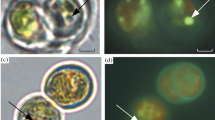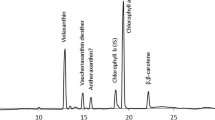Abstract:
The green alga Haematococcus pluvialis accumulates massive amounts of the red pigment astaxanthin in response to stimuli inducing it to form cysts. During the encystment process the cell wall undergoes a clear hardening and thickening. In this work, a cell wall fraction withstanding successive acid and basic hydrolysis was isolated and proves to be algaenan by Fourier transform infrared spectroscopy. This compound is equally abundant in nonmotile vegetative cells and astaxanthin-rich cysts. This finding indicates that the synthesis of algaenan does not require the activation of the machinery for the massive production of secondary carotenoids. We conclude that algaenan cannot cause the changes occurring in the cell wall during the encystment process without the involvement of other cell wall components.
Similar content being viewed by others
Author information
Authors and Affiliations
Additional information
Received November 7, 2000; accepted April 3, 2001.
Rights and permissions
About this article
Cite this article
Montsant, A., Zarka, A. & Boussiba, S. Presence of a Nonhydrolyzable Biopolymer in the Cell Wall of Vegetative Cells and Astaxanthin-Rich Cysts of Haematococcus pluvialis (Chlorophyceae). Mar. Biotechnol. 3, 515–521 (2001). https://doi.org/10.1007/s1012601-0051-0
Issue Date:
DOI: https://doi.org/10.1007/s1012601-0051-0




